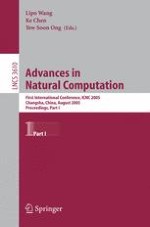2005 | Buch
Advances in Natural Computation
First International Conference, ICNC 2005, Changsha, China, August 27-29, 2005, Proceedings, Part I
herausgegeben von: Lipo Wang, Ke Chen, Yew Soon Ong
Verlag: Springer Berlin Heidelberg
Buchreihe : Lecture Notes in Computer Science
